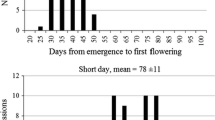Summary
The times from sowing to first flowering (f) of 231 accessions of lentil (Lens culinaris Medik.), comprising germ plasm from eight countries and breeding lines from ICARDA in Syria, were recorded in four glasshouse environments; two photoperiods (16 and 13 h/day) combined with warmer (24°/13°C) and cooler (18°/9°C) day/night temperatures. The linear model 1/f=a+bT + cP (where T is mean diurnal temperature and P is photoperiod) provided an average fit over the 231 accessions of r 2=0.852. Since there is no interaction term in this linear model, the flowering responses of an accession to temperature and photoperiod are independent. The values of the constants b and c indicate relative responsiveness of rate of progress towards flowering (1/f) to temperature and photoperiod, respectively. Comparison among the 231 accessions showed a weak, but significant, negative correlation between the values of b and c (r=-0.291, P<0.01). Since the proportion of the variance of b not attributed to its linear regression on c was >0.91, we conclude that these phenological responses are under separate control and that there is considerable scope for selection of any combination of sensitivities to temperature and photoperiod in lentil. Just as a large proportion of the variation among accessions in mean time to first flowering was attributed to country of origin, so also was variability in the values of the constants a, b, and c. In particular, sensitivity to photoperiod (i.e., the value of constant c) was dependent upon latitude of origin. Breeding lines from ICARDA were equally variable in a, b, and c as were germ plasm accessions from elsewhere, while the mean values were similar to those of accessions from neighboring Jordan. A single accession of wild lentil (L. culinaris subsp. orientalis) from Turkey showed flowering responses to T and P similar to the mean value of accessions of cultivated lentil from that country. Results from diverse environments for the Argentinian cv Precoz show that the use of this linear model facilitates predictions of time to flowering in any environment (within wide limits) of known mean temperature and photoperiod. The model, then, minimizes the need for multisite evaluations of phenology, since predictions of pre-flowering duration in any environment, and characterization of flowering responses to photoperiod and temperature, can now be achieved by screening germ plasm in a few, carefully selected locations.
Similar content being viewed by others
References
Barulina H (1930) Lentils of the USSR and other countries. Bull Appl Bot Genet Plant Breed Leningrad (Suppl 40): 265–304
Ellis RH, Hadley P, Roberts EH, Summerfield RJ (1990) Quantitative relations between temperature and crop development and growth. In: Jackson MT, Ford-Lloyd B, Parry M (eds) Climatic change and plant genetic resources. Belhaven Press, London pp. 85–115
Erskine W, Hawtin GC (1983) Pre-breeding in faba beans and lentils. Genetika 15:287–294
Erskine W, Witcombe JR (1984) Lentil germ plasm catalog. ICARDA, Aleppo, Syria
Erskine W, Adham Y, Holly L (1989) Geographic distribution of variation in quantitative characters in a world lentil collection. Euphytica 43:97–103
Frankel OH (1989) Principles and strategies of evaluation. In: Brown AHD, Frankel OH, Marshall DR, Williams JT (eds) The use of plant genetic resources. Cambridge University Press, Cambridge, pp 245–260
Gray LN, Delgado de NC (1990) Environmental variation in time to flower in lentil. LENS (in press)
IBPGR (1985) Oat descriptors. International Board for Plant Genetic Resources, Rome
IBPGR (1989) Annual report 1988. International Board for Plant Genetic Resources, Rome
ICARDA (1987) Food Legume International Testing Program Report — 1984/85. International Center for Agricultural Research in the Dry Areas, Aleppo, Syria
Roberts EH, Summerfield RJ (1987) Measurement and prediction of flowering in annual crops. In: Atherton JG (ed) Manipulation of flowering. Butterworth, London, pp 17–50
Roberts EH, Summerfield RJ, Muehlbauer FJ, Short RW (1986) Flowering in lentil (Lens culinaris Medic.): the duration of the photoperiod inductive phase as a function of accumulated day length above the critical photoperiod. Ann Bot 58:235–248
Summerfield RJ, Muehlbauer FJ (1982) Controlled environments as an adjunct to field research on lentils (Lens culinaris). II. Research strategy. Exp Agric 18:3–15
Summerfield RJ, Roberts EH (1987) Effects of illuminance on flowering in long- and short-day grain legumes. In: Atherton JG (ed) Manipulation of flowering. Butterworth, London, pp 203–223
Summerfield RJ, Muehlbauer FJ, Roberts EH (1985a) Lens culinaris Medic. In: Halevy AH (ed) A handbook of flowering, vol 1. CRC Press, Florida, pp 118–124
Summerfield RJ, Roberts EH, Erskine W, Ellis RH (1985b) Effects of temperature and photoperiod on flowering in lentils (Lens culinaris Medic.). Ann Bot 56:659–671
Weisberg S (1980) Applied linear regression. Wiley, New York
Author information
Authors and Affiliations
Additional information
Communicated by H. F. Linskens
Rights and permissions
About this article
Cite this article
Erskine, W., Ellis, R.H., Summerfield, R.J. et al. Characterization of responses to temperature and photoperiod for time to flowering in a world lentil collection. Theoret. Appl. Genetics 80, 193–199 (1990). https://doi.org/10.1007/BF00224386
Received:
Accepted:
Issue Date:
DOI: https://doi.org/10.1007/BF00224386




